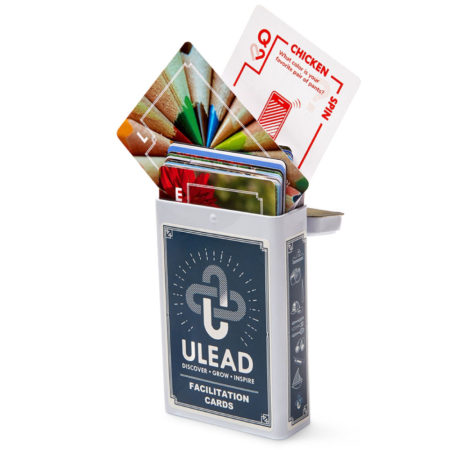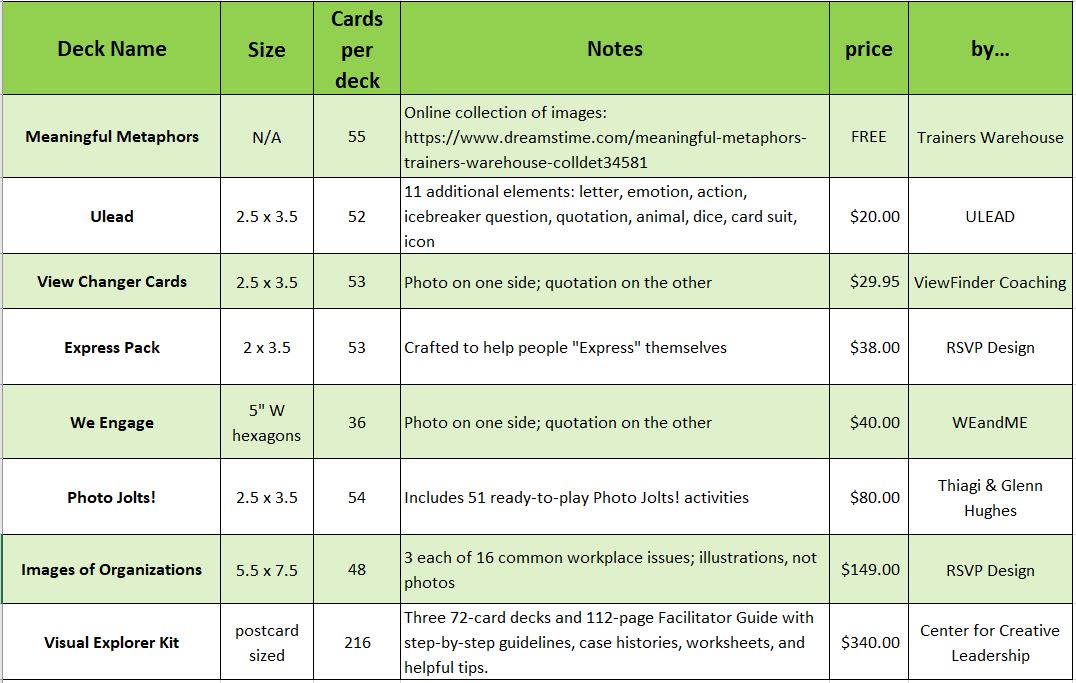Photo Decks for Conversation Starters & Memorable Training
Have you come across a Photo Deck or other set of Conversation Cards recently? You know those decks of innumerable glorious and provocative images? Perhaps you’ve seen them and wondered what use they might be. Photo Decks are popular for their huge variety of applications, especially as conversation starters. Some trainers and teachers even create their own with their phone camera, or by collecting postcards (back when travel was common!). Explore the dozens of ways you can use Photo Decks effectively and understand what makes a picture deck-worthy.
Photo Decks Boost Creativity and Engagement
We’ve collected over a dozen ways that trainers, teachers, and therapists can use photo decks and photographic collections for a variety of learning activities:
1) Icebreakers and Introductions
- Personal pictures: Ask participants to select an image that represents…
- A hobby.
- A goal for the session.
- A fact few people know about you.
- Complementary pictures: Select an image and find 2 or more people with a complementary images. Discuss the similarities of the images and/or develop a story that weaves the images together.
2) Team game debriefs and conversation starters
Ask participants to select an image that reflects:
- Feelings – How they were feeling at the start of the exercise.
- Observations – An observation they gained during the exercise.
- Learning Moments – A feeling or learning point they hope to take with them.
- Team Dynamics – How you wish your team functioned. You might say, “Pick a number of cards which illustrate your expectations of this team.”
- Leadership – Find a photo that reminds you the leadership quality you most hope to develop.
3) Learning reinforcement
- Memory Builders – Identify an idea you definitely want to remember. Select a photo to tie to that memory. Create an exaggerated story about the image and the idea to be remembered. Going forward, when you see the image, you’ll remember the material as well.
- Emotional Intelligence – Develop a vocabulary for feelings by identifying different emotions evoked by each image.
4) Facilitation
- Change Management – Prior to a change initiative, ask individuals or teams to identify a card which represents the state of the organization now, and another to show how they would like it to be in the future.
- Leadership and Management – Bring clarity to a situation by asking the group to “pick 5 cards that represent your vision of what is important to you and your role.”
- Coaching – Use cards to encourage discussion and reflection on progress made through a coaching journey.
 What makes a Photographic Conversation Cards Worth 1000 Words?
What makes a Photographic Conversation Cards Worth 1000 Words?
The value and interpretation of any image is really in the eyes of the beholder. Every person will see something different in an image, which is also what makes it fun to use pictures. Consider, for instance, the image of a bunch of pointed colored pencils. One might explain that they picked that card because it suggests…
- Creativity – Colored pencils allow people to create or draw anything they can imagine.
- Artistry – I’m an artist and love drawing.
- Points of View- The multiple pencil points remind me of the different points of view I must consider.
- Precision – The points coming together in one place, reminds me that I need to pay closer attention to details.
Create Amazing Picture Collections to Start Deep Conversations
A photo’s beauty isn’t enough to make it a good choice for inclusion in metaphoric photo decks. In addition to the image being clear and attractive, we look for these qualities:
Variety across images: Look for a collection of images to evoke a broad range of emotions, perspectives, interests, etc.
Versatility within an image: Be sure each image is rich enough that it can be used in a number of ways.
Viewpoints: Put yourself in others’ shoes and include images that might appeal to folks with different interests.
Finding the right deck+
Trainers Warehouse has curated 9 collections. Each varies in size of the cards, number of images, price, and availability of facilitation notes.
Online Decks
Clearly, you have many options. And, if physical decks are not always practical because you’re working remotely, Trainers Warehouse has assembled a shareable collection of online photographs. To use these, virtual trainers can share the online link with attendees. Then, session participants can browse, select, download and discuss their favorite images.
Deckhive.com is another excellent tool to utilize online decks. It lets you select your favorite cards, swap them in and out, share notes, etc.
Whether you develop your own Photo Decks and conversation cards, or find one at Trainers Warehouse, you will surely get lots of use out of these incredibly versatile tools as memorable and useful conversation starters!
Read More:
Debriefing Tools: Finding the Perfect Debrief
Communication: Communication and Listening Exercises
Listening: Active Listening Exercises


